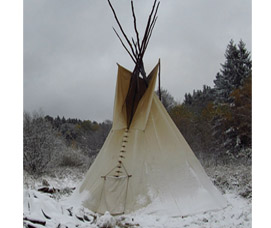
“All that the power of the universe does is in a circle, the sky is round, the sun rises and falls in a circle, the moon does the same, and they are round one and the other. .
The life of a man is a circle from infancy to childhood, and so it is with everything where the Power moves … so our tipis were round, like the nests of the birds, and always arranged in a circle … “
Black Moose, Indian Sioux oglala (born in 1863)
Tepee ou Tipi
Sioux word meaning “used to live indoors”
This conical tent, characteristic of the civilization of the plains, was a form of habitat, but also of transport (sled), symbol (pipe), etc … very widespread in North America.
The Amerindian tipi of the “civilizations of the plains” was probably – before the XVII century – identical to the one we know. Since the end of the 19th century, the tipi has attracted amateurs in Europe. At the beginning of the 20th century, the Scout movement of France revived it for its festivals inspired by Indian folklore.
Today, the tipi and the yurt are used by a variety of audiences, in very different contexts: reception structures offering holiday stays, people looking for a simple way of life, whether or not linked to a spiritual process …

The art of living in the tipi
For the Indians the tipi was a sacred place. The soil is the land on which we live. The walls are the sky and the poles symbolize the paths that lead from the earth to the spiritual world; the paths unite men to the Great Spirit called Wakatanka in the language of the Dakota Indians.
The shamans, in their astral journeys, used the pole as a way to the realm of the beyond to communicate with the spirits of nature.
Based on the Indian tradition of the plains, mainly Sioux, but also Cheyenne or Crows, improved in terms of finishes (seams, curbs, reinforcements, closing eyelets eyelets, fasteners of interior canvases, etc …), in order to to bring a reliability which corresponds to our way of life and our climates, our tipis, well of the XX century, would without question satisfied the creative genius of our illustrious predecessors!

